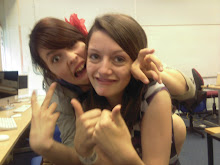Throughout my production I have been continually getting audience feedback so that my product could be as sucessful as possible.
- Due to my initial anamatic not proving popular with the focus group I had available (as it didn't have an interesting twist in it, a very important convention of short films) I decided to change my concept completely and merge it with a sinister cannibal story. When I ran this story past a selection of the target audience they were a lot more positive and so that is the one that I chose to develop.
- Once I had filmed my initial footage for the night time scene (the first scene that I filmed) I pieced it together in sequence and showed it to my media class [this rough cut can be found here]. They were able to give me good, useful audience feedback that I was able to use to improve the scene. They suggested focusing more on the arm shot, as it was difficult to see and needed highlighting, and also that I might want to draw out the ending a bit more as it was too abrupt. One person suggested showing some of his clothing discovered in the woods the next day by some passer-bys, and as other people agreed this would be effective I developed it.
- After I had filmed the internal scenes I pieced it together with the other footage and put the video on popular networking site Facebook. This was so that I could get an extensive range of feedback from my own age-group, as this is the target audience for my film. As I am friends with several media students on Facebook, I was able to get more technical advice, as well as general plot and aesthetic feedback from others. They suggested improving on the sound quality (which I did by adding in a voiceover when the girl speaks) and they provided suggestions for the type of music that I should use. One person suggested using the stereo to provide music and I developed this to produce the diegetic soundtrack that I settled on.
- Taken from the inital audience feedback I changed the shot of the arm and then added an extra section at the end, including fading titles (a common feature in many short films I researched) and a panning shot of the woods floor coming to rest on the male characters show that has been discarded. At this point I also had a soundtrack which I put on the footage. I then posted this new rough cut on Facebook to recieve more feedback.
- From this audience feedback I established that the soundtrack was popular, but the dance track at the start needed to be edited so that it wasn't quite so loud at the start. I then had the idea to make the music diegetic, growing louder and quieter depending where the camera was in relation to the stereo, and then cutting off when the door shut. Many people thought this was a good idea so I used it.
- At this point I had pretty much finished my editing, but I showed to my media class again to ensure that there wasn't anything else I could do to improve it in the time left. My media teacher suggested that I needed more exposition at the start that shows the relationship between the two characters, but then members of my target audience said that the begining was the right length, if not a little too long. As they were my target audience I decided to keep it the length it was. It was also suggested that I could add some foreshadowing about the cannibalism, either by including someone eating some meat in the background, the characters walking past a butcher shop, or some sort of poster in the background. Had I had the time to reshoot the scene, I wanted to put a large "Meat is Murder" poster behind the two girls as they enter, as in this film eating meat does actually invovle murdering a human being. Unfortunately I ran out of time and resources and was unable to include that.
- Also using the networking site Facebook I was able to publish my film poster and get audience feedback on that. It proved to be popular, and although it was suggested that I should take out the rating and BBFC mark, I felt that it would be sensible to keep these in as they are both common conventions of promotional film posters.








































